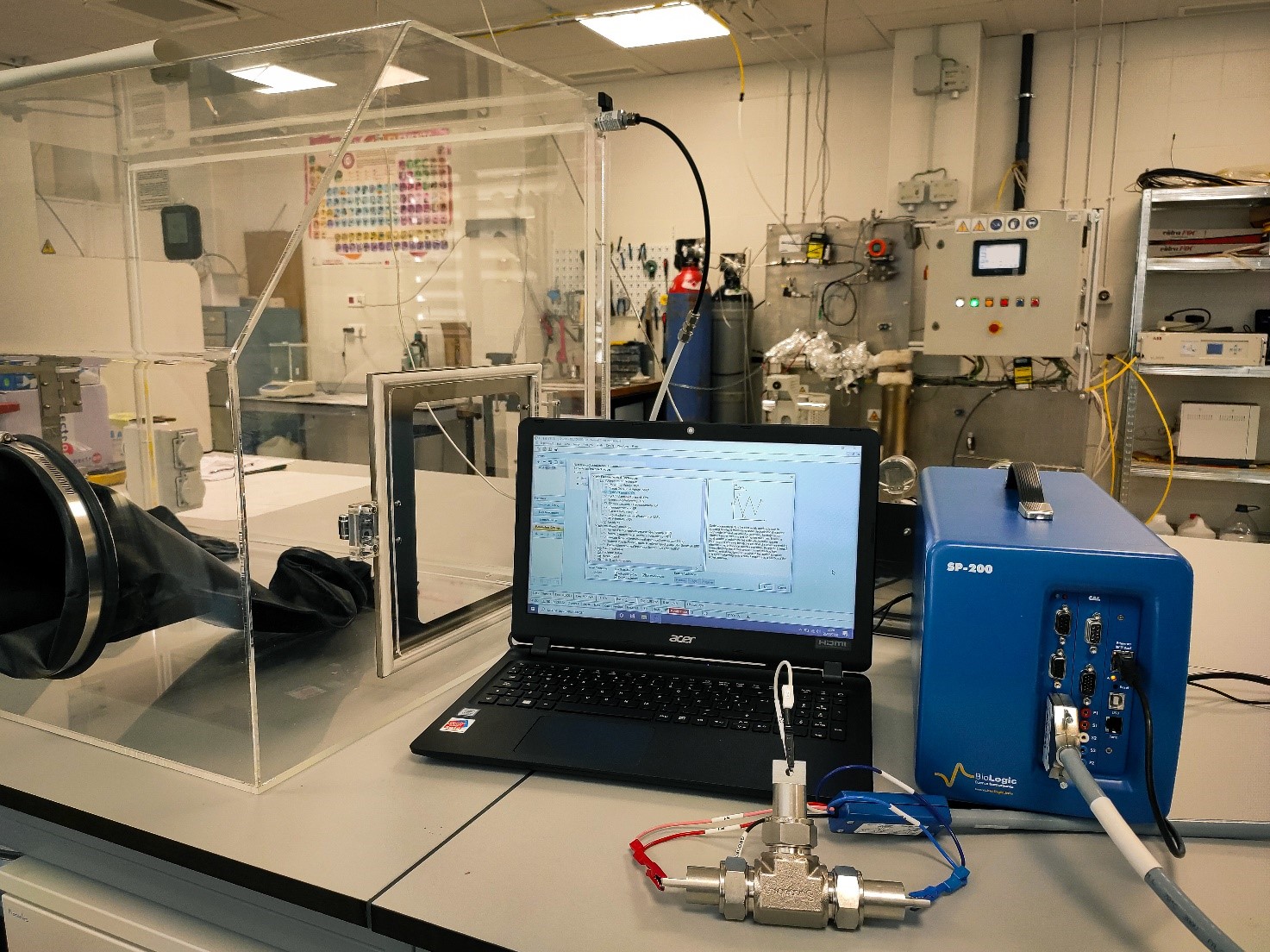SOBRE MÍ
Research Interests
- Producing biomass-derived chars by pyrolysis of agricultural wastes.
- Developing advanced carbon materials for thermal, catalytic and electrochemical applications.
- Activation and doping of engineered carbons as anodes for sodium-ion batteries.
Proyectos
- MEDWASTE —Mediterranean Agricultural Wastes: Environmentally Sustainable Resource for an Innovative Renewable Energy Technology (PCIN-2017-048)
- BIOCARB-ion —Engineered biochar-derived carbons as anodes for sodium- and potassium-ion batteries (PID2019-107737RB-I00)

PUBLICATIONS
2023
Antorán, Daniel; Alvira, Darío; Peker, M. Eser; Malón, Hugo; Irusta, Silvia; Sebastián, Víctor; Manyà, Joan Josep
Waste Hemp Hurd as a Sustainable Precursor for Affordable and High-Rate Hard Carbon-Based Anodes in Sodium-Ion Batteries Artículo de revista
En: Energy Fuels, vol. 37, no 13, pp. 9650–9661, 2023, ISSN: 0887-0624, (Publisher: American Chemical Society).
@article{antoran_waste_2023,
title = {Waste Hemp Hurd as a Sustainable Precursor for Affordable and High-Rate Hard Carbon-Based Anodes in Sodium-Ion Batteries},
author = {Daniel Antorán and Darío Alvira and M. Eser Peker and Hugo Malón and Silvia Irusta and Víctor Sebastián and Joan Josep Manyà},
url = {https://doi.org/10.1021/acs.energyfuels.3c01040},
doi = {10.1021/acs.energyfuels.3c01040},
issn = {0887-0624},
year = {2023},
date = {2023-07-01},
urldate = {2023-07-01},
journal = {Energy Fuels},
volume = {37},
number = {13},
pages = {9650–9661},
abstract = {The present study reports the promising potential of waste hemp-hurd-derived carbons as anodes in sodium-ion batteries (SIBs). Carbons were produced through an easily scalable process consisting of pyrolysis of raw biomass at 500 °C followed by mild chemical activation of the resulting char through wet impregnation with K2CO3 and subsequent heating of the solid phase (after filtration and drying) up to 700 or 800 °C under nitrogen. The best electrochemical performance was observed for the hard carbon activated at a char-K2CO3 mass ratio of 1:4 and heated up to 800 °C, which exhibited an excellent initial coulombic efficiency (73%) and achieved reversible charge capacities of 267 and 79 mAh g–1 at 0.03 and 1 A g–1, respectively. This material also exhibited an impressive cyclic stability and rate capability, with a capacity retention of 96% after 300 cycles at a current density of 2 A g–1. This more than satisfactory performance could be related to the textural and structural features of the hard carbon, which include moderate interconnected microporosity (with pore sizes below 1 nm), an appropriate concentration of defects in the carbon structure, relatively large interplanar distances, and a certain number of closed pores.},
note = {Publisher: American Chemical Society},
keywords = {},
pubstate = {published},
tppubtype = {article}
}
2022
Alvira, Darío; Antorán, Daniel; Manyà, Joan Josep
Assembly and electrochemical testing of renewable carbon-based anodes in SIBs: A practical guide Artículo de revista
En: Journal of Energy Chemistry, vol. 75, pp. 457–477, 2022, ISSN: 2095-4956.
@article{Alvira2022b,
title = {Assembly and electrochemical testing of renewable carbon-based anodes in SIBs: A practical guide},
author = {Darío Alvira and Daniel Antorán and Joan Josep Manyà},
url = {https://linkinghub.elsevier.com/retrieve/pii/S209549562200479X},
doi = {10.1016/J.JECHEM.2022.09.002},
issn = {2095-4956},
year = {2022},
date = {2022-12-01},
urldate = {2022-12-01},
journal = {Journal of Energy Chemistry},
volume = {75},
pages = {457--477},
publisher = {Elsevier},
keywords = {},
pubstate = {published},
tppubtype = {article}
}
Alvira, Darío; Antorán, Daniel; Manyà, Joan Josep
Plant-derived hard carbon as anode for sodium-ion batteries: A comprehensive review to guide interdisciplinary research Artículo de revista
En: Chemical Engineering Journal, vol. 447, pp. 137468, 2022, ISSN: 1385-8947.
@article{Alvira2022,
title = {Plant-derived hard carbon as anode for sodium-ion batteries: A comprehensive review to guide interdisciplinary research},
author = {Darío Alvira and Daniel Antorán and Joan Josep Manyà},
url = {https://linkinghub.elsevier.com/retrieve/pii/S1385894722029564},
doi = {10.1016/J.CEJ.2022.137468},
issn = {1385-8947},
year = {2022},
date = {2022-11-01},
urldate = {2022-11-01},
journal = {Chemical Engineering Journal},
volume = {447},
pages = {137468},
publisher = {Elsevier},
keywords = {},
pubstate = {published},
tppubtype = {article}
}
2021
Manyà, Joan Josep; Alvira, Darío; Videgain, María; Duman, Gozde; Yanik, Jale
Assessing the Importance of Pyrolysis Process Conditions and Feedstock Type on the Combustion Performance of Agricultural-Residue-Derived Chars Artículo de revista
En: Energy & Fuels, 2021.
@article{Manya2021,
title = {Assessing the Importance of Pyrolysis Process Conditions and Feedstock Type on the Combustion Performance of Agricultural-Residue-Derived Chars},
author = {Joan Josep Manyà and Darío Alvira and María Videgain and Gozde Duman and Jale Yanik},
url = {https://dx.doi.org/10.1021/acs.energyfuels.0c04180},
doi = {10.1021/acs.energyfuels.0c04180},
year = {2021},
date = {2021-01-01},
journal = {Energy & Fuels},
publisher = {American Chemical Society},
abstract = {The combustion performance of chars derived from vine shoots, wheat straw, and corn stover was investigated to assess the influence of both the biomass precursor and pyrolysis operating conditions. Chars were produced through slow pyrolysis at different peak temperatures (350 and 500 °C), pressures (0.1 and 0.5 MPa), and residence times of the vapor phase (50 and 150 s). From the thermogravimetric curves obtained under air, the combustion performance index (S) was calculated for each char. Apparent kinetics were also estimated using the Coats−Redfern method and assuming an F3/2 reaction model. Results show that the combustion patterns of chars were more influenced by the type of feedstock than by the pyrolysis conditions. Corn stover appeared to be the most interesting feedstock in order to produce chars with tuned reactivity. Results from partial least-squares (PLS) regression revealed that the most important factors affecting S were the contents of potassium (negative effect) and cellulose (positive effect) in the original biomass.},
keywords = {},
pubstate = {published},
tppubtype = {article}
}
2019
Stasi, Christian Di; Alvira, Darío; Greco, Gianluca; González, Belén; Manyà, Joan Josep
Physically activated wheat straw-derived biochar for biomass pyrolysis vapors upgrading with high resistance against coke deactivation Artículo de revista
En: Fuel, vol. 255, pp. 115807, 2019, ISSN: 00162361.
@article{DiStasi2019,
title = {Physically activated wheat straw-derived biochar for biomass pyrolysis vapors upgrading with high resistance against coke deactivation},
author = {Christian Di Stasi and Darío Alvira and Gianluca Greco and Belén González and Joan Josep Manyà},
doi = {10.1016/j.fuel.2019.115807},
issn = {00162361},
year = {2019},
date = {2019-11-01},
journal = {Fuel},
volume = {255},
pages = {115807},
publisher = {Elsevier Ltd},
abstract = {Wheat straw-derived biochars (produced through slow pyrolysis at 500 °C and 0.1 MPa) were physically (with CO2) and chemically (with K2CO3) activated to assess their performance as renewable and low-cost catalysts for biomass pyrolysis vapors upgrading. Preliminary cracking experiments, which were carried out at 700 °C using a mixture of four representative model compounds, revealed a clear correlation between the volume of micropores of the catalyst and the total gas production, suggesting that physical activation up to a degree of burn-off of 40% was the most interesting activation route. Next, steam reforming experiments were conducted using the most microporous material to analyze the effect of both the bed temperature and gas hourly space velocity (GHSV) on the total gas production. The results showed a strong dependence between the bed temperature and the total gas production, with the best result obtained at the highest temperature (750 °C). On the other hand, the change in GHSV led to minor changes in the total gas yield, with a maximum achieved at 14500 h−1. Under the best operating conditions deduced in the previous stages, the addition of CO2 into the feed gas stream (partial pressure of 20 kPa) resulted in a total gas production of 98% with a H2/CO molar ratio of 2.16. This good result, which was also observed during the upgrading of the aqueous phase of a real biomass pyrolysis oil, was ascribed to the relatively high coke gasification rate, which refresh the active surface area preventing deactivation by coke deposition.},
keywords = {},
pubstate = {published},
tppubtype = {article}
}


